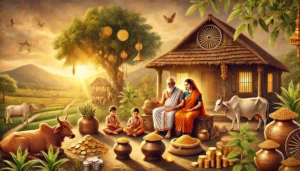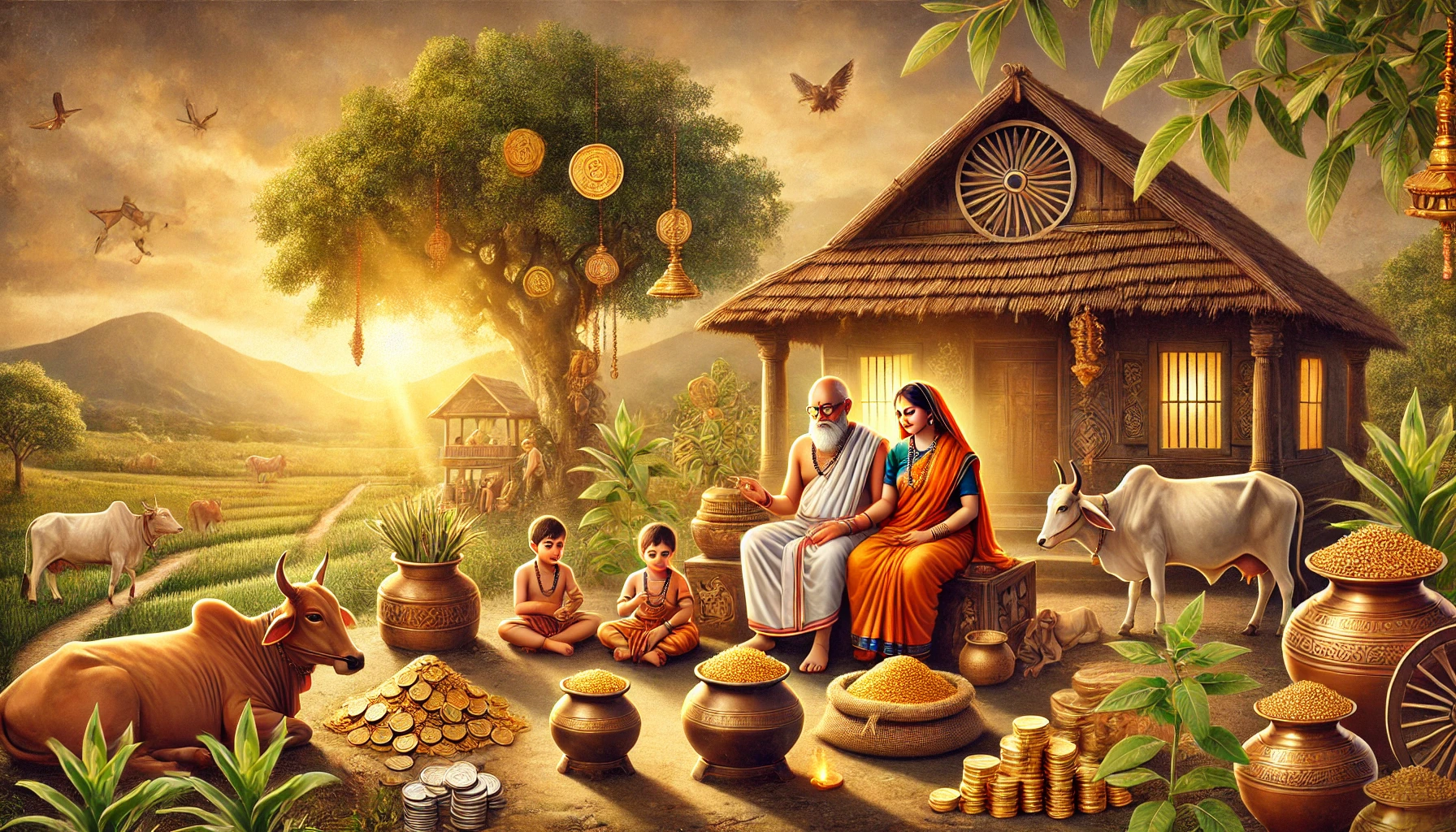
Grihastha Ashrama in wealth management
The Concept of “Grihastha Ashrama” and Wealth Accumulation
In the Vedic framework of Sanatan Dharma, life is divided into four ashramas or stages, each with its distinct role and purpose: Brahmacharya (studenthood), Grihastha (householder), Vanaprastha (forest-dwelling), and Sannyasa (renunciation). Among these, the Grihastha Ashrama holds a unique place as the foundation of social, economic, and spiritual life. It is during this stage that individuals actively engage with the world, accumulating wealth, nurturing relationships, and fulfilling responsibilities that sustain both family and society.
This article delves into the profound philosophy of Grihastha Ashrama, exploring its relevance, its approach to wealth accumulation, and its emphasis on the harmonious balance between material and spiritual pursuits.
Grihastha Ashrama: The Heart of Social Order
The Grihastha Ashrama typically begins with marriage, which marks the transition from the learning-focused phase of Brahmacharya to an active role as a householder. In this phase, individuals are expected to:
- Fulfill Family Duties: Provide for the material, emotional, and spiritual needs of the family.
- Support Society: Contribute to the well-being of the community through economic activities, charity, and social leadership.
- Sustain Other Ashramas: The householders are responsible for supporting students (Brahmacharis), forest-dwellers (Vanaprasthis), and renunciants (Sannyasis) by offering food, resources, and protection.
The householder thus becomes the pillar of society, creating the wealth and stability that enable the spiritual and social ecosystem to flourish. This interconnectedness underscores the essential role of Grihastha Ashrama.
Table of Contents

Grihastha Ashrama in wealth management
Wealth Accumulation in Grihastha Ashrama
Unlike some spiritual traditions that view wealth as a hindrance to enlightenment, Sanatan Dharma embraces wealth as a vital means to fulfill worldly and spiritual obligations. In the Grihastha Ashrama, wealth (artha) is not only permissible but necessary for living a life of Dharma (righteousness).
- The Ethical Pursuit of Wealth
The Vedic texts emphasize that wealth should be acquired through honest, ethical, and socially responsible means. The Manusmriti advises individuals to avoid greed and deception, reminding householders that wealth earned immorally leads to suffering rather than fulfillment.
Wealth, when accumulated through Dharma, becomes a force for good, enabling the householder to care for the family, assist the needy, and contribute to society. For instance, ancient texts often praise merchants and kings who used their wealth for charitable works, public welfare, and the patronage of art and culture.
- Balancing Wealth and Spirituality
While wealth is essential, it must never become the sole focus of life. The householder is encouraged to view wealth as a means rather than an end. The Bhagavad Gita warns against material attachment, teaching that true fulfillment comes from detachment and service to others.
In Grihastha Ashrama, wealth should:
- Fulfill Practical Needs: Cover basic requirements such as food, clothing, shelter, and education.
- Enable Generosity: Support charitable activities, including feeding the poor, helping the sick, and funding public works like wells, schools, and temples.
- Aid Spiritual Growth: Contribute to religious practices, rituals, and pilgrimages, reinforcing one’s connection to the divine.
This balance ensures that wealth serves as a tool for holistic well-being, not as a source of greed or ego.
Wealth and the Purusharthas
The pursuit of wealth in Grihastha Ashrama aligns with the Vedic concept of the four Purusharthas:
- Dharma (Righteousness): The moral foundation of life. Wealth must be earned and spent in alignment with one’s duties and ethical principles.
- Artha (Material Prosperity): The acquisition of resources necessary for a comfortable and meaningful life.
- Kama (Desires): The enjoyment of life’s pleasures, such as love, art, and culture, in a balanced manner.
- Moksha (Liberation): The ultimate goal of spiritual freedom, which can be achieved only when wealth and desires are pursued without attachment.
In the Grihastha Ashrama, Artha plays a central role, supporting the other three goals. A householder’s life demonstrates how material prosperity and spiritual growth are not mutually exclusive but deeply interconnected.
Charity and Social Contribution
One of the defining features of Grihastha Ashrama is its emphasis on dana (charity). The scriptures repeatedly highlight the importance of sharing one’s wealth with those in need. Charity is seen as a sacred duty (yajna), purifying the giver’s heart and strengthening the bonds of community.
Some forms of charity recommended in the scriptures include:
- Annadana (Food Donation): Feeding the hungry, especially during festivals and sacred occasions.
- Vastradana (Clothing Donation): Providing clothing to the poor.
- Vidya Dana (Education Donation): Supporting students and schools to promote learning and knowledge.
- Goshala Support: Contributing to the care of cows, which are considered sacred and vital to agrarian society.
Charity in Grihastha Ashrama is not merely an act of generosity but a way of redistributing wealth to ensure societal harmony and spiritual merit.
Lessons from Vedic Stories
The Vedic and Puranic texts offer numerous examples of ideal householders who accumulated wealth righteously and used it wisely:
- King Janaka: Renowned as a philosopher-king, Janaka balanced material prosperity with spiritual wisdom. Despite his wealth, he remained detached and used his resources to uplift his kingdom.
- Harishchandra: Known for his unwavering commitment to truth and Dharma, Harishchandra demonstrated how wealth should never compromise one’s integrity.
- Yudhishthira: The eldest Pandava emphasized the ethical acquisition and distribution of wealth, ensuring prosperity for his people while remaining humble and just.
These stories remind us that wealth, when aligned with Dharma, can lead to both material success and spiritual fulfillment.

Grihastha Ashrama in wealth management
Relevance of Grihastha Ashrama in Modern Times
In today’s world, the principles of Grihastha Ashrama hold immense relevance. Amid rapid economic growth and consumerism, it is easy to lose sight of ethical and spiritual values. The wisdom of Grihastha Ashrama encourages us to:
- Earn Ethically: Avoid shortcuts, exploitation, or harm in the pursuit of wealth.
- Spend Wisely: Prioritize needs over wants, balancing personal desires with societal obligations.
- Share Generously: Support charitable causes and contribute to the greater good.
- Stay Grounded: Remember that wealth is a means to an end, not the ultimate goal of life.
By incorporating these principles, we can create a life of purpose and harmony, contributing to both personal fulfillment and societal progress.
Conclusion
The Grihastha Ashrama is a celebration of life’s responsibilities and opportunities. It teaches us that wealth is neither to be rejected nor worshipped but embraced as a tool for righteous living. By earning wealth ethically, using it responsibly, and sharing it generously, householders can achieve the delicate balance between material prosperity and spiritual growth.
In embracing the timeless wisdom of Grihastha Ashrama, we can transcend the narrow confines of self-interest and create a life that uplifts not just ourselves but everyone around us. This is the essence of Sanatan Dharma—a harmonious blend of duty, prosperity, and liberation.
FAQs for “Understanding Grihastha Ashrama: The Role of Wealth in a Balanced Life”:
- What is Grihastha Ashrama?
Grihastha Ashrama is the second stage of life in Sanatan Dharma, following Brahmacharya (student life). It represents the householder stage, where individuals take on responsibilities like marriage, family, earning a livelihood, and contributing to society, while following the principles of dharma (righteousness).
- Why is Grihastha Ashrama considered the most important stage of life?
Grihastha Ashrama is often called the “pillar of society” because it supports all other Ashramas (Brahmacharya, Vanaprastha, and Sannyasa). As householders provide resources, charity, and guidance, they enable society to function harmoniously.
- How does Grihastha Ashrama define wealth accumulation?
In Grihastha Ashrama, wealth accumulation is encouraged as a means of fulfilling one’s responsibilities to family, society, and spiritual growth. It must be acquired through ethical means and utilized wisely for righteous purposes.
- Is there a limit to wealth accumulation in Grihastha Ashrama?
While there is no fixed limit, scriptures emphasize that wealth should not lead to greed or excessive attachment. Wealth should be sufficient to fulfill one’s dharmic duties, provide security, and contribute to social welfare.
- How does wealth support dharma in Grihastha Ashrama?
Wealth enables individuals to perform their responsibilities, such as providing for their families, supporting societal needs, contributing to religious ceremonies, and engaging in charitable acts (Dana), which are integral to living a righteous life.
- What is the significance of charity (Dana) in Grihastha Ashrama?
Charity is a vital aspect of Grihastha Ashrama. Householders are encouraged to share their wealth with the less fortunate, support spiritual institutions, and promote welfare. Dana not only helps others but also purifies the giver’s soul.
- How does Grihastha Ashrama balance material and spiritual life?
Grihastha Ashrama teaches householders to enjoy life’s material comforts responsibly while maintaining a focus on spiritual progress. This balance is achieved by adhering to dharma, practicing gratitude, and avoiding attachment to material possessions.
- Does Grihastha Ashrama discourage luxury or indulgence?
While moderate enjoyment of material comforts is allowed, excess indulgence, greed, and selfish use of wealth are discouraged. The focus is on maintaining harmony and using wealth for constructive purposes.
- How does Grihastha Ashrama prepare individuals for later stages of life?
By fulfilling their duties and accumulating wealth responsibly, householders cultivate selflessness and detachment, preparing them for the transition to Vanaprastha (retirement) and Sannyasa (renunciation).
- How can modern professionals apply the principles of Grihastha Ashrama?
Modern professionals can adopt these principles by earning ethically, prioritizing family, giving back to society, and living with a balance of material and spiritual pursuits. These principles remain highly relevant in contemporary lifestyles.
- What is the role of family in Grihastha Ashrama?
Family forms the core of Grihastha Ashrama. It is through familial relationships that householders practice selflessness, compassion, and responsibility, which are essential for personal and spiritual growth.
- How does wealth contribute to spiritual growth in Grihastha Ashrama?
Wealth is a tool for spiritual growth when used wisely. By supporting religious activities, helping others, and reducing financial stress, wealth enables individuals to focus on higher spiritual goals.
- What are the key duties of a householder in Grihastha Ashrama?
The key duties include:
Fulfilling familial responsibilities (raising children, supporting a spouse, and caring for elders).
Earning wealth ethically to support the family and society.
Practicing charity (Dana) and supporting the community.
Participating in religious and cultural activities.
Striving for spiritual growth while balancing worldly duties.
- How do scriptures guide wealth management in Grihastha Ashrama?
Scriptures like Manusmriti and the Bhagavad Gita emphasize ethical earning, responsible spending, and using wealth for dharmic purposes. They caution against hoarding and attachment, advocating generosity and balance.
- What is the relationship between Artha (wealth) and Moksha (liberation) in Grihastha Ashrama?
Artha, or wealth, is considered a means to achieve dharma and ultimately Moksha. Proper management of wealth allows individuals to fulfill their worldly duties, practice selflessness, and focus on spiritual liberation.
- Can a householder achieve spiritual liberation while fulfilling material duties?
Yes, Grihastha Ashrama shows that spiritual liberation (Moksha) can be achieved by living a dharmic life. By performing one’s duties selflessly and using wealth righteously, a householder progresses spiritually without renouncing worldly life.
- How is the concept of renunciation different in Grihastha Ashrama and Sannyasa?
In Grihastha Ashrama, renunciation is internal—detachment from greed, ego, and excessive desires while fulfilling duties. In Sannyasa, renunciation is external, involving a complete withdrawal from material possessions and societal roles.
- What are the potential challenges of following Grihastha Ashrama in modern times?
Challenges include maintaining ethical earning practices in competitive environments, balancing family and work responsibilities, and staying connected to spiritual values in a materialistic world.
- How can one practice detachment in Grihastha Ashrama?
Detachment involves fulfilling duties with dedication but without becoming overly attached to outcomes, wealth, or possessions. This is achieved through self-awareness, gratitude, and a focus on higher spiritual values.
- What role does spirituality play in managing wealth in Grihastha Ashrama?
Spirituality ensures that wealth is seen as a means, not an end. It guides ethical earning, responsible spending, and a focus on using wealth for selfless purposes, fostering both material and spiritual well-being.
Summary
The concept of Grihastha Ashrama, or the householder stage in Hindu philosophy, emphasizes living a life of responsibility, balance, and contribution to society. This stage is marked by fulfilling familial, social, and spiritual duties while embracing the ethical accumulation and utilization of wealth.
Wealth, in the context of Grihastha Ashrama, is not seen as a source of greed or indulgence but as a necessary resource to support one’s family, assist the needy, perform dharmic duties, and contribute to the welfare of society. The emphasis is on earning wealth through righteous means (dharma) and using it for both material and spiritual upliftment.
This stage serves as the backbone of societal prosperity, connecting individual progress with collective well-being. By integrating wealth with wisdom and values, Grihastha Ashrama teaches the art of living a balanced life while preparing for the subsequent stages of spiritual evolution.
Related Articles
- Restful Nights: Ayurvedic Remedies and Traditional Indian Practices to Overcome Insomnia and Late-Night Habits
- The Tridevi: Lakshmi, Saraswati, and Parvati – Their Roles and Powers
- “Divine Creatures of Ancient Indian Scriptures: Exploring the Role of Animals in the Vedas, Puranas, and Mahabharata”
- Nature and Spirituality: Exploring the Sacred Essence of the Himalayas, Ganga, and Other Natural Wonders”
- “Reviving the Gurukul System: Relevance and Lessons for Modern Education”
- “Exploring Greek and Indian Mythology: Similarities Between Greek and Indian Mythology “
- “Embracing Sattvic Living: Harmonizing Mind, Body, and Soul Through Food and Lifestyle”
- “Charity and Prosperity: Exploring the Concept of Daan and Its Financial Relevance in Modern Life”
- How to Build an Eco-Friendly Home Inspired by Vastu Shastra
- Comparison of Ancient and Modern Sports: How Traditional Sports Have Influenced Contemporary Games
- “Timeless Lessons from Ancient Tales: Linking Samudra Manthan and Ganga’s Descent to Modern Ecological Challenges”
- “Reviving Sanskrit: How AI is Preserving Ancient Languages for the Future”
- “Mathura: The Sacred Land of Lord Krishna’s Divine Leelas”
- Investing for Future Generations: Lessons from Indian Traditions on Legacy Building and Wealth Preservation
- “Ancient Indian Wisdom: Timeless Lessons for Tackling Today’s Climate Crisis”
- “Artificial Intelligence and Spirituality: Transforming Ancient Practices for the Modern World”
- “Gold and Real Estate in India: Timeless Assets Shaping Financial Strategies”
- Tradition Meets Innovation: The Evolution of Technology in Hindu Rituals
- End-of-World Myths: Exploring Kali Yuga in Hinduism and Ragnarök in Norse Mythology
- Garuda, Pegasus, and Dragons: The Universal Ties of Mythical Beasts Across Cultures
- “Ancient Vimanas: Mythical Flying Machines or Evidence of Advanced Technology?”
- Time Travel in Hindu Mythology: The Fascinating Tales of Kakudmi and King Raivata
- “Divine Feminine Power in Hindu Mythology: The Legends of Durga, Saraswati, and Lakshmi”
- “Divine Beings of Sanatan Dharma: The Spiritual Significance of Sacred Animals in Hinduism”
- “Symbolism in Mythological Art: Unlocking Hidden Meanings in Ancient Temple Carvings”
- “Exploring Technological Advancements in Ancient India and Civilizations: Vimana, Metallurgy, & Water Management systems”
- Unveiling the Mysteries: Ancient Temples of Sanatan Dharma , Mysterious Temples of India
- “The Scientific Knowledge of Sanatan Dharma: Ancient Wisdom Meets Modern Science”
- Ancient Indian Sports and Games: Celebrating a Legacy of Skill, Strength & Strategy”
- “Exploring the Cosmic Link: The Connection Between Astronomy and Vedic Astrology”
- The Power of Sanskrit: Unlocking the Divine Language of the Gods
- “The End of Kaliyuga: A Sanatan Insight into the World’s Final Chapter”
- Explore more articles on Prachin Sanatan Yuga.
Grihastha Ashrama in wealth management Grihastha Ashrama in wealth management Grihastha Ashrama in wealth management Grihastha Ashrama in wealth management Grihastha Ashrama in wealth management Grihastha Ashrama in wealth management Grihastha Ashrama in wealth management Grihastha Ashrama in wealth management Grihastha Ashrama in wealth management Grihastha Ashrama in wealth management
Grihastha Ashrama in wealth management Grihastha Ashrama in wealth management Grihastha Ashrama in wealth management Grihastha Ashrama in wealth management Grihastha Ashrama in wealth management Grihastha Ashrama in wealth management Grihastha Ashrama in wealth management Grihastha Ashrama in wealth management Grihastha Ashrama in wealth management Grihastha Ashrama in wealth management
Grihastha Ashrama in wealth management Grihastha Ashrama in wealth management Grihastha Ashrama in wealth management Grihastha Ashrama in wealth management Grihastha Ashrama in wealth management Grihastha Ashrama in wealth management Grihastha Ashrama in wealth management Grihastha Ashrama in wealth management Grihastha Ashrama in wealth management Grihastha Ashrama in wealth management
